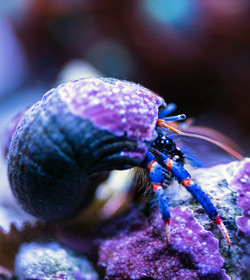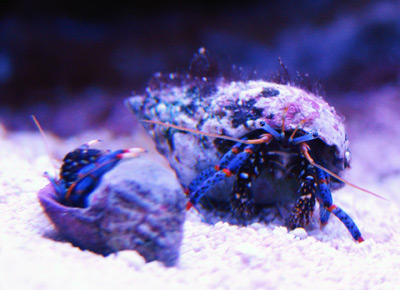Clibanarius tricolor, the blue-legged hermit crab, is very commonly introduced to marine aquaria, either in conspecific groups or as part of a multi-species “reef janitor” package or “cleanup crew” (aka “CUC” for those who just can’t get enough of those marine aquarium acronyms), for the purpose of aiding in detritus and algae control. But does this little hermit really perform as advertised and is it truly reef safe?
Based on my personal experience with keeping blue-legged hermits, I would answer both of these questions with a resounding “maybe.” Before adding C. tricolor to your aquarium—especially in large numbers—consider the following four caveats:
1. It’s an opportunistic omnivore
What this point should tell you is, C. tricolor won’t necessarily limit its menu to the algae, detritus, and uneaten food you want it to consume. For example, some specimens may kill and eat resident snails and then abscond with their shells. Also, like any animal, they prefer to acquire meals via the path of least resistance, so they’re not averse to snatching away food intended for corals or other sessile invertebrates. If sufficiently motivated by hunger, some specimens may even feast upon the invertebrates themselves.

2. Hermit crabs climb on corals
These hermits don’t exactly respect corals’ personal space. In fact, they’ll routinely climb right over them. This may sound insignificant, but those pointy little legs can irritate corals’ tissues to the extent that they refuse to expand. If that persists for a prolonged period, the affected coral specimen’s health will suffer. Of course, the more hermits you add to the system, the greater the potential for this problem.
3. You can’t correlate the stocking rate with tank volume

While we’re on the subject of numbers, it’s not unusual to come across stocking recommendations such as “add one blue-legged hermit crab per gallon of aquarium capacity.” I wholeheartedly disagree with this advice and any variations upon it. The volume of water an aquarium holds tells you virtually nothing about how many hermits a system can reasonably sustain. A horde of hungry hermits swarming over the aquascape may soon deplete available food sources, making it more likely that valued livestock will be targeted for consumption. And did I mention that corals don’t like a steady stream of hermits clambering over them?
It’s always best to start with a smaller number of hermits, observe how they behave and perform their janitorial duties, and then add more specimens only if appropriate.
4. They won’t reverse an algae plague
If you have a major outbreak of hair algae or some other irksome type, adding blue-legged hermits—even by the handful—won’t solve the problem. In my experience, the hermits will contentedly pick out and consume bits of food and detritus trapped in the algae (creating the impression that they’re feeding on the algae) but leave the tough strands in place. In this situation, you’ll need to address and rectify the underlying cause of the outbreak (an excess of dissolved nutrients) and then do a lot of manual removal to get the problem under control.



